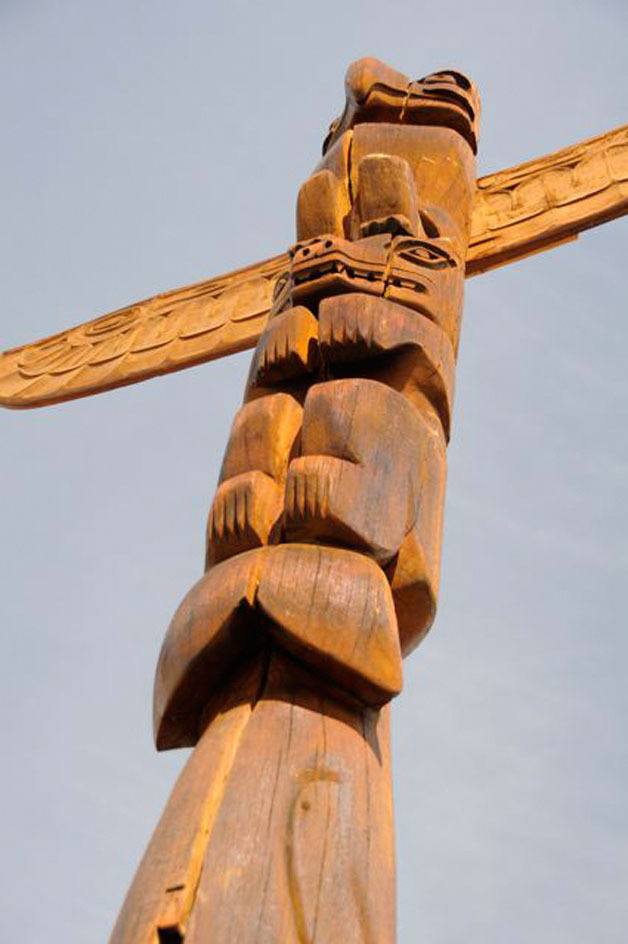Oscar Leighton Hilbert’s hand-carved thunderbird wings are once again flying high above South Whidbey.
Hilbert, who lived at Mutiny Bay in Freeland before he died in 2008 at age 87, was an avid woodworker who gained some measure of fame for carving the seal that adorns the mayor’s conference room at Seattle’s city hall.
During his time on South Whidbey, the artist spent much time carving a totem pole at his home in Mutiny Sands, taking great effort to mimic the artistic style of the Haida Indians.
More than a generation old, the pole was donated by Hilbert’s children to Community Thrift a few years ago. It’s since been restored and raised outside the Freeland store with help from members of the community. A celebration is planned for 3 p.m. Monday, Sept. 19.
Hilbert had great respect for Pacific Northwest coastal Indian art and became an accomplished carver.
“His home was built in the shape of a teepee,” said Community Thrift employee Annie Carson.
The totem pole was carved out of a 100-year-old cedar log and includes the descending forms of a thunderbird, a bear, an orca, a raven and a beaver. It stands more than 24 feet high and weighs about 800 pounds.
Carson said that it took Hilbert five years to carve the pole and that he would have appreciated the fact that his son Roger Hilbert and daughter Patsy Hilbert donated it to the store so that it could be viewed from Highway 525 and enjoyed by Whidbey Islanders and visitors alike.
“We wanted the island to be able to share it forever,” Roger Hilbert said.
Hilbert remembers the cabin fondly and his father was building the three-story house with eight sides and the big fireplace in the middle, and how he culled the huge cedar log from the beach.
“It was carved sometime between 1965 and 1972 and sat at our cabin for 40-some odd years facing the Olympics,” he said.
“Every summer he carved one figure,” Roger Hilbert recalled.
Each figure on the pole represents a member of the family, Roger Hilbert said. His father, the thunderbird; his mother, Mary, the bear; Roger, the orca; a raven for his sister Patsy; and the beaver, his younger brother, Leigh.
Oscar Leighton Hilbert, known as “Leighton,” was probably best known in Seattle for having carved the city seal that adorns the mayor’s conference room at Seattle City Hall.
Roger Hilbert had been working as a city architect helping to remodel the old city hall.
“I told them about my father. He spent a whole year carving the city seal of Chief Seattle,” he said.
“He didn’t want to be paid, but his one request was that the city set up a scholarship fund for Native Americans.”
The artist donated the seal in 1971, but the $1,000 scholarship fund was not put in place until 2002 under the administration of then-mayor Greg Nickels.
Roger Hilbert said his father was a quiet, powerful man of high integrity who possessed an intellectually curious mind. He was an inventor, a furniture maker, a business man, a man raised close to the land, a cowboy from Eastern Oregon who rode a horse to school, and a friend to the neighboring Umatilla Indians.
“He never raised his voice,” his son said. “He was a storyteller and very funny. He was a great guy and everybody respected him.”
After the totem pole was blown down during the strong winds of early 2009, many of the artist’s friends and neighbors offered to buy the pole. And with the house on the market, the family had to decide what to do with the hand-carved monument.
“We explored different ideas, but agreed we wouldn’t sell it and that it needed to be installed somewhere in the community,” Roger Hilbert said.
The talk soon turned to Community Thrift, where his parents did much of their shopping.
“Dad bought all his clothes there,” he said. “They shopped there all the time. That’s why we picked that place.”
The pole was in no shape to be put up right away, however. Enter Freeland resident Brad Thompson.
“I’m a fan of Northwest Indian carvings and I saw the pole wrapped in a blue tarp for a couple of summers and thought it should be brought back to its original form,” Thompson said.
Thompson went to work on the restoration, which took about two-and-a-half months working on and off in his wood shop. Thompson researched the background of the artist and thought of Leighton Hilbert while he worked, hoping to do his work credit.
“I built some supports, filled in the cavities that had been rotted out and created a copper hat for the top,” Thompson said.
Thompson was joined by some of the employees at the thrift store, who helped put a marine finish on the pole to protect it from the weather.
“We should get another 50 years out of it, at least,” he said.
The pole was put up last week, with the help of community members and the thrift store crew. Bruce Bell Tractor Landscaping, Rempel Brothers Concrete, Nichols Brothers Boat Builders, Frontier Building Supply, Ace Hardware and Inspired Gardens were instrumental in the installation process.
“Dad originally wanted the totem pole to go to the community. Now it’s there and everybody can enjoy it,” Roger Hilbert said.



